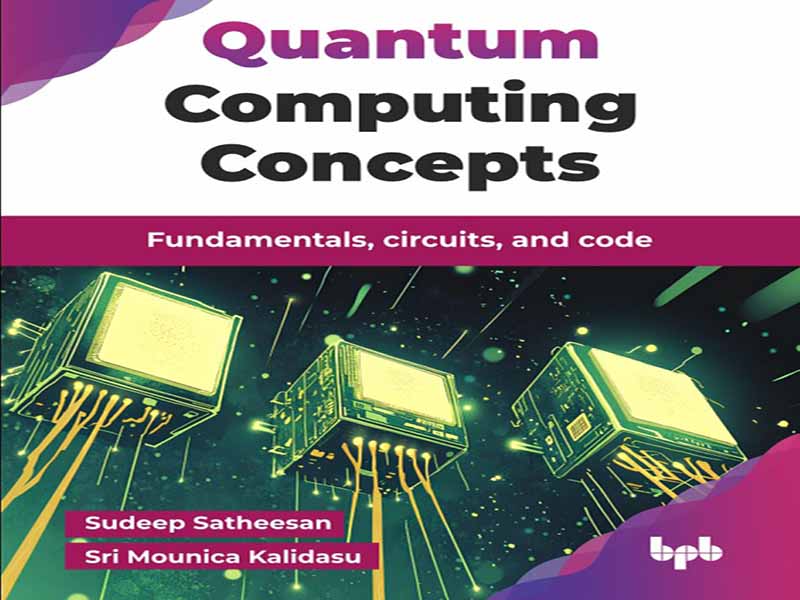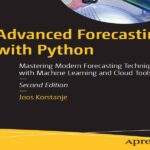- عنوان کتاب: Quantum Computing Concepts
- نویسنده: Sudeep Satheesan Sri Mounica Kalidasu
- حوزه: محاسبات کوانتومی
- سال انتشار: 2025
- تعداد صفحه: 573
- زبان اصلی: انگلیسی
- نوع فایل: pdf
- حجم فایل: 14.7 مگابایت
محاسبات کوانتومی، عصر جدیدی از قابلیتهای محاسباتی را آغاز میکند که محدودیتهای اساسی محاسبات کلاسیک را به چالش میکشد و درهایی را به سوی امکانات بیسابقه میگشاید. همزمان با پیمایش این چشمانداز به سرعت در حال تحول توسط محققان، مهندسان و علاقهمندان، درک کاملی از اصول، الگوریتمها و کاربردهای کوانتومی ضروری است. این کتاب به عنوان یک راهنمای جامع برای مفاهیم اصلی محاسبات کوانتومی، از مکانیک کوانتومی بنیادی گرفته تا پیادهسازیهای عملی با استفاده از ابزارهای معاصر مانند Qiskit و IBM Q، عمل میکند. این کتاب با بررسی موضوعاتی مانند برهمنهی، درهمتنیدگی، دروازههای کوانتومی، تصحیح خطای کوانتومی و ارتباطات کوانتومی، قصد دارد دانش لازم برای درک ظرافتهای پردازش و محاسبات اطلاعات کوانتومی را در اختیار خوانندگان قرار دهد. در سراسر این کتاب، جنبههای مختلف محاسبات کوانتومی را پوشش میدهیم و با اصول اساسی که آن را از محاسبات کلاسیک متمایز میکند، شروع میکنیم. انواع مختلف کامپیوترهای کوانتومی و معماریهای آنها را بررسی میکنیم و اطمینان حاصل میکنیم که خوانندگان رویکردهای متنوع اتخاذ شده در این زمینه را درک میکنند. در ادامه، دروازهها و مدارهای کوانتومی، نمایشهای ریاضی آنها و نقش آنها در محاسبات کوانتومی را بررسی میکنیم. ابزارهای عملی مانند Qiskit و IBM Q برای کمک به خوانندگان در آزمایش الگوریتمهای کوانتومی و کسب تجربه عملی معرفی شدهاند. علاوه بر این، این کتاب مباحث مهمی مانند ارتباط کوانتومی، تصحیح خطا و طراحی گیتهای کلاسیک با استفاده از گیتهای کوانتومی را پوشش میدهد و دیدگاهی جامع در مورد پتانسیل و چالشهای محاسبات کوانتومی ارائه میدهد. فصل 1: اصول محاسبات کوانتومی – مفاهیم اساسی محاسبات کوانتومی، از جمله ماهیت ذرات زیر اتمی، اصول اساسی مکانیک کوانتومی و پدیدههای کلیدی کوانتومی مانند برهمنهی و درهمتنیدگی را معرفی میکند. فصل 2: انواع کامپیوترهای کوانتومی – مروری بر انواع مختلف کامپیوترهای کوانتومی، معماریهای آنها و تفاوت آنها با الگوهای محاسبات کلاسیک ارائه میدهد. فصل 3: برهمنهی و درهمتنیدگی – اصول کلیدی کوانتومی که محاسبات کوانتومی را از محاسبات کلاسیک متمایز میکند و پیامدهای آنها برای کارایی محاسباتی را بررسی میکند. فصل 4: گیتها و مدارهای کوانتومی – بلوکهای سازنده اساسی مدارهای کوانتومی، از جمله گیتهای کوانتومی مختلف و نمایشهای ریاضی آنها را پوشش میدهد. فصل 5: مقدمهای بر Qiskit و IBM Q خوانندگان را با چارچوب Qiskit و IBM Q آشنا میکند و تجربه عملی در اجرای آزمایشهای کوانتومی را ارائه میدهد. فصل 6: طراحی گیتهای منطقی کلاسیک با استفاده از گیتهای کوانتومی – بررسی میکند که چگونه میتوان گیتهای منطقی کلاسیک را با استفاده از گیتهای کوانتومی طراحی کرد و پیامدهای آنها در مدلهای محاسباتی چیست. فصل 7: ارتباطات کوانتومی – جنبههای کلیدی ارتباطات کوانتومی، از جمله کدگذاری فوق چگال، انتقال کوانتومی و توزیع کلید کوانتومی را مورد بحث قرار میدهد. فصل 8: تصحیح خطای کوانتومی – ضرورت تصحیح خطا در محاسبات کوانتومی و تکنیکهای مختلف مورد استفاده برای کاهش خطاها را توضیح میدهد. فصل 9: الگوریتمهای کوانتومی – الگوریتمهای کوانتومی اساسی مانند جستجوی گروور و الگوریتم شور را معرفی میکند و نشان میدهد که چگونه محاسبات کوانتومی میتواند در حوزههای خاص مسئله از روشهای کلاسیک پیشی بگیرد. فصل 10: کاربردهای کامپیوترهای کوانتومی در صنایع – بررسی میکند که چگونه محاسبات کوانتومی در صنایع مختلف، از جمله رمزنگاری، بهینهسازی، مراقبتهای بهداشتی، علوم مواد و هوش مصنوعی، انقلابی ایجاد میکند. این کتاب برای دانشجویان، محققان و متخصصانی طراحی شده است که مشتاق درک و بهکارگیری اصول محاسبات کوانتومی هستند. چه در این زمینه تازهکار باشید و چه به دنبال تعمیق دانش خود باشید، این کتاب راهنمایی ساختاریافتهای با بینشهای نظری، مبانی ریاضی و مثالهای عملی برای پر کردن شکاف بین نظریه و کاربرد ارائه میدهد. در پایان این کتاب، خوانندگان پایه محکمی در مفاهیم محاسبات کوانتومی، درک وضعیت فعلی فناوری و چشمانداز روشنی از تأثیر متحولکنندهای که محاسبات کوانتومی ممکن است بر زمینههایی مانند رمزنگاری، بهینهسازی، هوش مصنوعی و فراتر از آن داشته باشد، خواهند داشت. امیدوارم این کتاب به عنوان منبعی ارزشمند در سفر شما به دنیای جذاب محاسبات کوانتومی مفید باشد.
Quantum computing is ushering in a new era of computational capabilities, challenging the fundamental limitations of classical computing and opening doors to unprecedented possibilities. As researchers, engineers, and enthusiasts navigate this rapidly evolving landscape, a solid understanding of quantum principles, algorithms, and applications is essential. This book serves as a comprehensive guide to the core concepts of quantum computing, from foundational quantum mechanics to practical implementations using contemporary tools such as Qiskit and IBM Q. By exploring topics such as superposition, entanglement, quantum gates, quantum error correction, and quantum communication, this book aims to provide readers with the knowledge required to grasp the nuances of quantum information processing and computation. Throughout this book, we cover various aspects of quantum computing, starting with the fundamental principles that distinguish it from classical computing. We examine the different types of quantum computers and their architectures, ensuring readers understand the diverse approaches taken in the field. Moving forward, we explore quantum gates and circuits, their mathematical representations, and their role in quantum computation. Practical tools such as Qiskit and IBM Q are introduced to help readers experiment with quantum algorithms and gain hands-on experience. Additionally, the book covers crucial topics like quantum communication, error correction, and the design of classical gates using quantum gates, offering a holistic perspective on the potential and challenges of quantum computing. Chapter 1: Principles of Quantum Computing- Introduces the fundamental concepts of quantum computing, including the nature of subatomic particles, fundamental quantum mechanics principles, and key quantum phenomena such as superposition and entanglement. Chapter 2: Types of Quantum Computers- Provides an overview of different types of quantum computers, their architectures, and how they differ from classical computing paradigms. Chapter 3: Superposition and Entanglement- Explores the key quantum principles that distinguish quantum computing from classical computing and their implications for computational efficiency. Chapter 4: Quantum Gates and Circuits- Covers the basic building blocks of quantum circuits, including various quantum gates and their mathematical representations. Chapter 5: Introduction to Qiskit and IBM QIntroduces readers to the Qiskit framework and IBM Q, providing hands-on experience in running quantum experiments. Chapter 6: Design of Classical Logic Gates Using Quantum Gates- Examines how classical logic gates can be designed using quantum gates and their implications in computational models. Chapter 7: Quantum Communication- Discusses key aspects of quantum communication, including superdense coding, quantum teleportation, and quantum key distribution. Chapter 8: Quantum Error Correction- Explains the necessity of error correction in quantum computing and various techniques used to mitigate errors. Chapter 9: Quantum Algorithms- Introduces fundamental quantum algorithms such as Grover’s search and Shor’s algorithm, demonstrating how quantum computing can outperform classical methods in specific problem domains. Chapter 10: Applications of Quantum Computers Across Industries- Explores how quantum computing is revolutionizing various industries, including cryptography, optimization, healthcare, material science, and artificial intelligence. This book is designed for students, researchers, and professionals who are eager to understand and apply quantum computing principles. Whether you are new to the field or seeking to deepen your knowledge, this book provides structured guidance with theoretical insights, mathematical foundations, and practical examples to bridge the gap between theory and application. By the end of this book, readers will have a strong foundation in quantum computing concepts, an appreciation for the current state of the technology, and a clear vision of the transformative impact quantum computing may have on fields such as cryptography, optimization, artificial intelligence, and beyond. I hope this book serves as a valuable resource in your journey into the fascinating world of quantum computing.
این کتاب را میتوانید از لینک زیر بصورت رایگان دانلود کنید:
Download: Quantum Computing Concepts




































نظرات کاربران